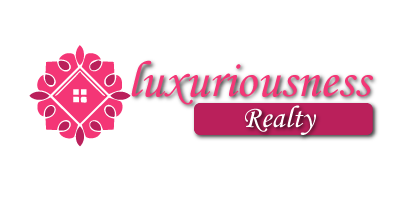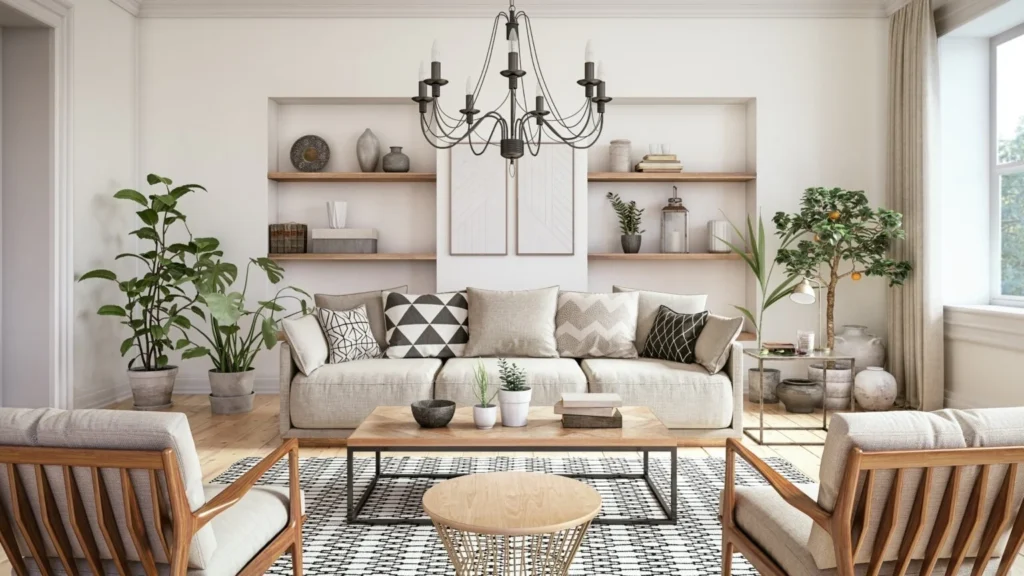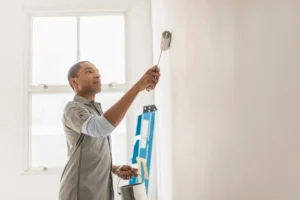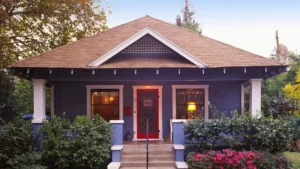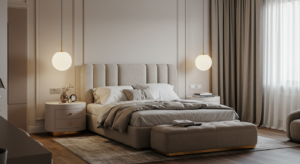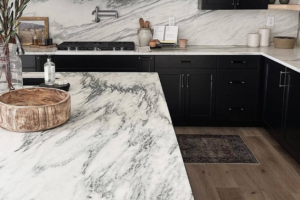Imagine stepping into a room bathed in natural light, with clean lines, neutral colors, and a cozy ambiance that immediately makes you feel at home. A single, unadorned wooden table sits in the center, flanked by sleek chairs, while soft, plush throws and cushions add warmth to the minimalist aesthetic. This is not just any room—it embodies the very essence of Scandinavian interior design. Known for its simplicity, functionality, and connection to nature, this design style has taken the world by storm, becoming a global phenomenon that appeals to those who crave beauty and practicality.
The Roots of Scandinavian Design
Scandinavian interior design originated in the Nordic countries of Sweden, Norway, Denmark, and Finland in the early 20th century. These regions’ harsh winters, long nights, and minimal daylight significantly influenced the design principles. The need to create bright, functional, and cozy living spaces led to developing a design style that celebrates simplicity, efficiency, and a deep connection to the outdoors.
According to a 2023 report by Global Market Insights, Scandinavian design has seen a 30% increase in global market demand in the last decade, mainly due to its focus on sustainability and functionality. As homeowners prioritize eco-friendly choices and minimalism, Scandinavian design has emerged as one of the most sought-after interior styles worldwide.
Minimalism at Its Core
At the heart of Scandinavian interior design is minimalism. The design philosophy emphasizes decluttering and creating open, airy, and calm spaces. There is a saying in Scandinavian design: “Less is more.” it’s principle guides every decision, from furniture choices to décor items.
This doesn’t Scandinavian interiors are cold or impersonal. On the contrary, minimalism in Scandinavian design is about removing unnecessary distractions while maintaining warmth and comfort. Clean lines and simple forms dominate, but they are softened with natural materials like wood, wool, and leather.
In a 2022 survey by Houzz, 45% of homeowners listed minimalism as their top reason for choosing Scandinavian interiors. The report also found that spaces designed with minimalism in mind led to a 20% increase in overall mental well-being, as clutter-free environments are known to reduce stress and promote relaxation.
Light and Airy Spaces
Given Scandinavia’s long, dark winters, maximizing natural light is crucial in Scandinavian design. Homes are often painted in light, neutral colours like white, beige, or light gray to reflect natural light and make rooms feel brighter and more open. Large windows, often unadorned by heavy curtains or blinds, are a staple of this design style, allowing sunlight to flood the space.
According to a Zillow study, homes with larger windows and more natural light sell 15% faster than those without. The Scandinavian focus on light and airy spaces is one reason this design has become so popular: it fosters a sense of openness and tranquility, making even smaller spaces feel expansive.
The Use of Natural Materials
Nature plays a significant role in Scandinavian interiors. Using natural materials like wood, stone, wool, and leather connects the indoors with the outdoors, creating a sense of harmony with nature. Wood, in particular, is a hallmark of Scandinavian design, whether it’s it’s flooring, furniture, or accent pieces.
Light woods like oak, ash, and pine are commonly used to maintain a bright and airy aesthetic. Sherwin-Williams reports that 60% of Scandinavian-inspired homes feature natural wooden elements, adding warmth and texture to otherwise minimalist spaces.
Wool, leather, and linen also contribute to Scandinavian design’s cozy, organic feel. These materials are often used in throws, cushions, and upholstery, bringing softness and comfort to the clean, simple furniture lines.
Functionality and Practicality
One of the defining characteristics of Scandinavian design is its focus on functionality. Every piece of furniture or décor serves a purpose, often seamlessly blending form and function. Built-in storage, multi-functional furniture, and an emphasis on craftsmanship ensure that every item in the room is beautiful and practical.
In Scandinavian homes, you’re only to find excessive decorations or purely ornamental pieces. Instead, spaces are filled with aesthetically pleasing and useful items. According to IKEA’ home design report, 55% of people chose Scandinavian furniture for its functional design, citing multi-use pieces like storage benches and modular shelving units as top choices for urban living.
Hygge: The Art of Coziness
Scandinavian design is more than just a visual style—it’s ait’s of life. One of the key concepts that influence Scandinavian interiors is the Danish idea of “hygge” which” loosely translates to a sense of coziness and contentment. Hygge is about creating a warm, inviting atmosphere where people can relax and feel at ease.
Incorporating hygge into Scandinavian design often means adding soft textures, warm lighting, and inviting spaces that encourage relaxation and socializing. Every element, from fluffy rugs to dimmable lights, is carefully chosen to enhance comfort.
A study by The Danish Tourism Board found that homes with hygiene principles in mind reported a 40% increase in occupant happiness and satisfaction, reinforcing that comfort is a critical element of Scandinavian interiors.
Sustainability in Scandinavian Design
Sustainability is another core principle of Scandinavian design. Focusing on natural materials, durable furniture, and timeless design helps reduce waste and encourages environmentally friendly choices. Scandinavian interiors often favor quality over quantity, with homeowners investing in fewer but longer-lasting pieces.
In a 2022 survey by The Sustainable Furnishings Council, 50% of respondents who embraced Scandinavian design did so because of its eco-friendly focus. This commitment to sustainability and the minimalist approach has made Scandinavian design particularly popular among younger generations who prioritize environmental responsibility.
Popular Colour Palettes
While neutral colors dominate Scandinavian interiors, there is still room for subtle pops of color. Pale blues, soft greens, and muted pinks are often used as accent colours to add personality to a space without overwhelming the minimalist aesthetic. These colors are inspired by the natural landscapes of Scandinavia, from the cool blue of the fjords to the soft green of the forests.
In a 2023 Better Homes and Gardens report, Scandinavian-inspired homes with subtle color accents saw a 10% increase in visual appeal, especially in spaces like bedrooms and living rooms. These muted tones enhance calm and serenity, aligning with creating a peaceful home environment.
Statistics on Scandinavian Interior Design
The global popularity of Scandinavian interior design is undeniable. According to Statista, the Scandinavian furniture and décor market has grown by 25% since 2020, with countries outside Scandinavia—like the U.S., U.K., and Australia—embracing the style. The rising demand for minimalist, functional, and sustainable home designs drives this growth.
A 2023 study by The National Association of Realtors found that homes featuring Scandinavian interiors sold 20% faster than those with more traditional designs, proving that the style is visually appealing and an intelligent investment for homeowners.
Conclusion: Timeless Elegance
Scandinavian interior design is a timeless, versatile style that continues to resonate with homeowners across the globe. It offers a perfect blend of beauty and practicality, whether you’re looking at its minimalist aesthetic, focus on functionality, or embrace of natural materials. Scandinavian interiors provide a blueprint for living a more thoughtful, balanced life, from light and neutral colours to the emphasis on creating cozy, inviting spaces.
As you explore the world of Scandinavian design, remember that it’s ait’s more than just appearances. Its pilot’s sophy values simplicity, sustainability, and comfort—principles that can transform any space into a serene, stylish retreat.
